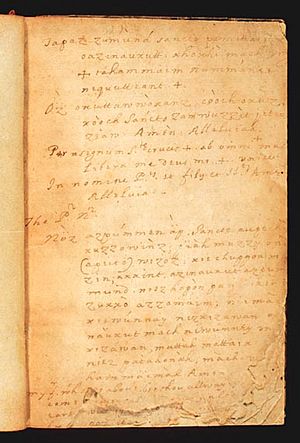Andrew White facts for kids
Quick facts for kids Father Andrew White |
|
|---|---|

Andrew White baptizing the chief Chitomachon
|
|
| Personal details | |
| Born | 1579 London, Kingdom of England |
| Died | December 27, 1656 (aged 76–77) Kingdom of England |
| Denomination | Roman Catholic |
Andrew White (1579 – December 27, 1656) was an English Jesuit missionary. He played a big part in starting the Maryland colony. He wrote down many important details about the early colony. His writings tell us about the land, the Native Americans there, and the Jesuit mission in North America.
Because he worked hard to teach and convert the native people, he is often called the "Apostle of Maryland." He is also seen as an important person in the history of Georgetown University. A building on the university's campus, White-Gravenor, is named after him.
Contents
Early Life and Education
Andrew White was born in London in 1579. When he was 14, he started his formal education. He went to the English College in Douai, France. In 1595, he joined the English College of St. Alban's in Valladolid, Spain. Other important English Catholic priests, like Thomas Garnet, were also there.
White studied more in Seville. He became a priest in Douai in 1605. After that, he went back to England.
Challenges in England
Around this time, many Catholics were being arrested. This happened after an event called the Gunpowder Plot. White was arrested in 1606 and sent away from England. He moved to Leuven in Belgium. On February 1, 1607, he joined the Society of Jesus, also known as the Jesuits.
Even though he could face serious punishment, White returned to Southern England in 1609 to preach. He also worked as a leader at seminaries in Leuven and Liège. He split his time between these roles and his missions in England.
Planning the Maryland Colony
George Calvert, the first Baron Baltimore, became Catholic in 1625. Many believe White helped him with this decision. After 1628, Calvert wrote to White from his colony in Newfoundland.
White became very interested in missions to America. In 1629, the leader of the Jesuits, Mutio Vitelleschi, approved a mission to America for White. George Calvert died in 1632, but his son, Leonard Calvert, continued the plan. Leonard wanted White to help start a new colony in the Chesapeake Bay area. This colony was officially approved on June 20, 1632.
White himself wrote about how good it would be to convert the native people. In 1633, he strongly suggested Catholic settlement in "lord Baltimore's Plantation in Mary-land." He described a beautiful land with large forests and rich soil. He even advertised 2,000 acres of land for each person who wanted to settle there.
Missionary Work in Maryland
On November 22, 1633, White accepted Baltimore's offer. He sailed from Cowes on the Isle of Wight with Leonard Calvert. They traveled on a ship called The Ark. Other Jesuits, John Altham Gravenor and Thomas Gervase, were also with them.
Founding the Colony
They landed on St. Clement's Island on March 25, 1634. This day marks the beginning of the Maryland colony. Today, this date is celebrated as Maryland Day. On that day, White held the first Catholic mass in the original thirteen English colonies.
By July 1634, White had written his first report about the new colony. It was called A Relation of the Sucessefull Beginnings of the Lord Baltimore's Plantation in Maryland. Parts of this report were used to encourage more people to come to the colony.
Working with Native Americans
White spent almost ten years in St. Mary's City. He worked on building good relationships between the English and Native Americans. He worked especially with the Yaocomico tribe. Because of White, this tribe often got good trade deals from Calvert. He also worked with the Anacostans.
In 1637, other Jesuits, Thomas Copley and Ferdinand Poulton, joined them. Between 1634 and 1650, there were usually four permanent Jesuits in the Maryland Colony. To help with his missionary work, White created dictionaries. He also translated the catechism (a book of Christian teachings) into native languages.
On July 5, 1640, he famously converted Chitomachon. Chitomachon was the chief of the Piscataway Indians. The chief was baptized as Charles. Later, White also baptized a princess of the Patuxent Indians and many people from her tribe.
Return to England
A war in England, called the English Civil War, stopped White's missionary work. In 1644, Richard Ingle and other colonists from the nearby Virginian colony of Jamestown attacked St. Mary's City. Jamestown had not welcomed George Calvert before. Ingle burned the town and, with help from William Claiborne, took control of the Maryland Colony.
White was arrested again because he was preaching as a Catholic. In 1645, he and Thomas Copley were sent in chains to London. There, he faced a trial. The charge was that he had returned to England after being told to leave in 1606. This crime could lead to the punishment of death. He was able to avoid this fate. He argued that he did not return to England by his own choice. His requests to go back to Maryland were denied. He spent the last ten years of his life quietly in England. He died on December 27, 1656.
See Also
Images for kids




